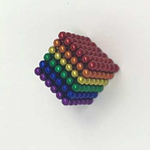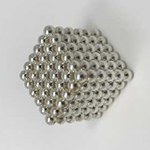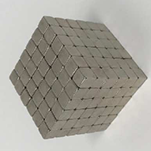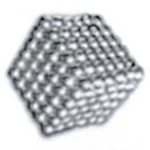Key Points
-
When filling a coloured image of a registered design, carefully consider whether the colour should be claimed.
-
When filing an application to invalidate a registered design, check that any evidence has a verifiable date of when it was made available to the public.
On 26 March 2019, Lin Bing (an individual) applied for invalidation of each of three registered designs owned by Wild Boards Limited (a UK online retailer) on the grounds that they were not new and did not have individual character. The registered designs related to games which are cubes made up of smaller spheres or cubes.
Lin Bing claimed that the designs first appeared in Wikipedia in 2009 and were the subject of an article on the website of The Daily Mail (“Mail Online”) in 2014, which was before the date of registration of the designs (25 July 2018).
Neither side asked for a hearing, therefore on 20 January 2020 a Decision was issued on the papers.
The Designs
First design - a cube of multicoloured spheres.

The design registration included a disclaimer: “No claim is made for the colour shown; no claim is made for the pattern of the spheres”
Second and third designs - a cube of silver spheres; and a cube of metal cubes


There were no disclaimers for the second or third designs.
The prior art
The invalidation application relied on two pieces of evidence. The first was a Wikipedia entry relating to “Neodymium magnet toys” which reported that sphere magnets sold as toys were launched at the New York International Gift Fair in 2009.The entry includes an image of a cube of spheres. However, the Hearing Officer stated that there is nothing to indicate exactly when that image was made available to the public. At the time of making the decision the Wikipedia entry was last updated on 27 January 2019, which was after the registration date of the designs. This piece of evidence was dismissed.
The second piece of evidence was an article from the Mail Online with the title “Magnet toys to be banned after toddler died swallowing seven balls and 7,700 children were admitted to hospital”. The article was dated 5 September 2014 and was updated later the same day.It contains a fuzzy image of a cube made from spherical magnets:

The date of publication of the Mail Online article was considered to be reliable and this image could therefore be used as prior art.
Decision
The Hearing Officer considered who the informed user would be, the design freedom available, the design corpus, the prior art, and the arguments submitted by the proprietor in their counterstatement.
The informed user is the person who considers the overall impression a design makes on them to help determine if it has individual character. In this case the informed user was considered to be “a person who uses games and toys and takes a particular interest in their features. They may also be a parent, relative or carer who chooses and buys games and toys to give to children”.
With regard to design freedom, it was noted that the overall shape (cube) and the shape of the components making up the design as a whole (spheres or cubes) are both specified. However, “the number and size of these components may differ. The designer may also choose to include surface decoration”.
No further evidence of the design corpus (essentially, the other designs for products of that type which existed at the date of creation of the design in question) was submitted beyond the two online articles. No assessment could therefore be made on how far the registered designs would stand out from other cubes made up of spheres or cubes.
The proprietor argued that the first design is “a unique pattern of six colours, not seen in any of the evidence”. But in the decision, the officer stated that since the first design registration included a disclaimer for the colour, the colours and colour pattern could not be considered. When the colour was discounted, the design related to a cube of 6 x 6 x 6 spheres which appear very similar (but not identical) to the cube illustrated in the Mail Online article. The second design was also a cube of 6 x 6 x 6 spheres which look similar to the cube shown in the Mail Online article. The first and second designs were found to be invalid for lack of individual character.
The third design is a cube made up of smaller cubes instead of spheres. This is very different in appearance from a cube of spheres, and it was considered that this would create a different overall impression on an informed user. The third design was held to be novel and to have individual character in view of the prior art.
The first and second designs were found to be invalid. The third design remains registered. The design proprietor, Wild Boards Limited, was ordered to pay Lin Bing costs towards the proceedings.
In this case it’s likely that the first design would have been valid if the colour had not been disclaimed. It’s therefore important to carefully consider whether or not to disclaim the colour or other surface decoration when filing registered design applications.
Any questions for Gail about the topic of this article? Contact her: gtaylor@kilburnstrode.com
Photographs sourced from Design Decision O/039/20